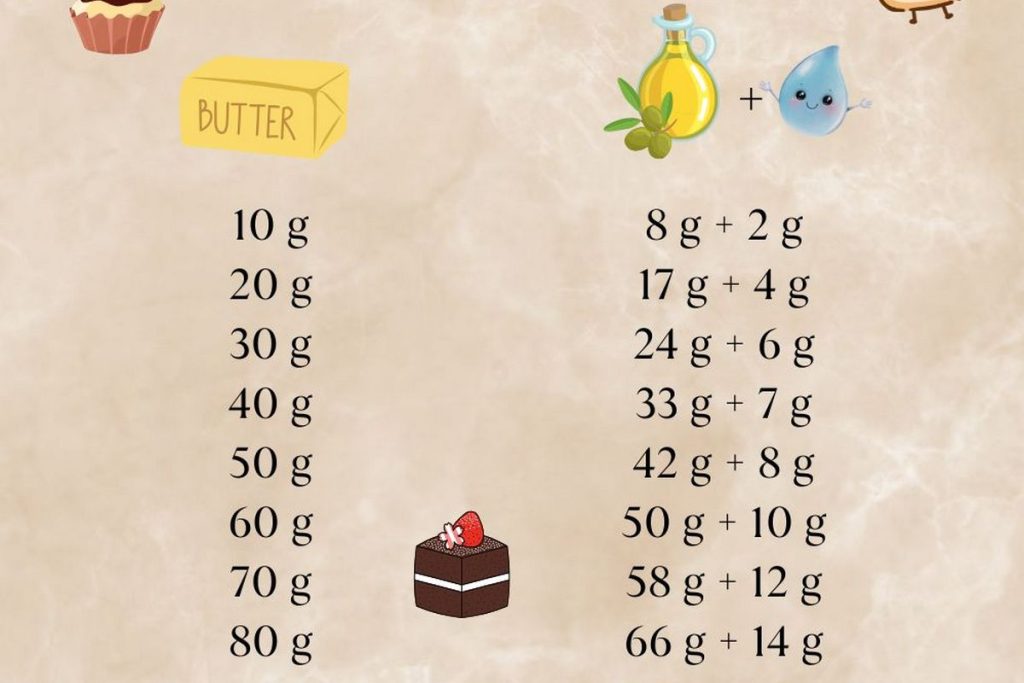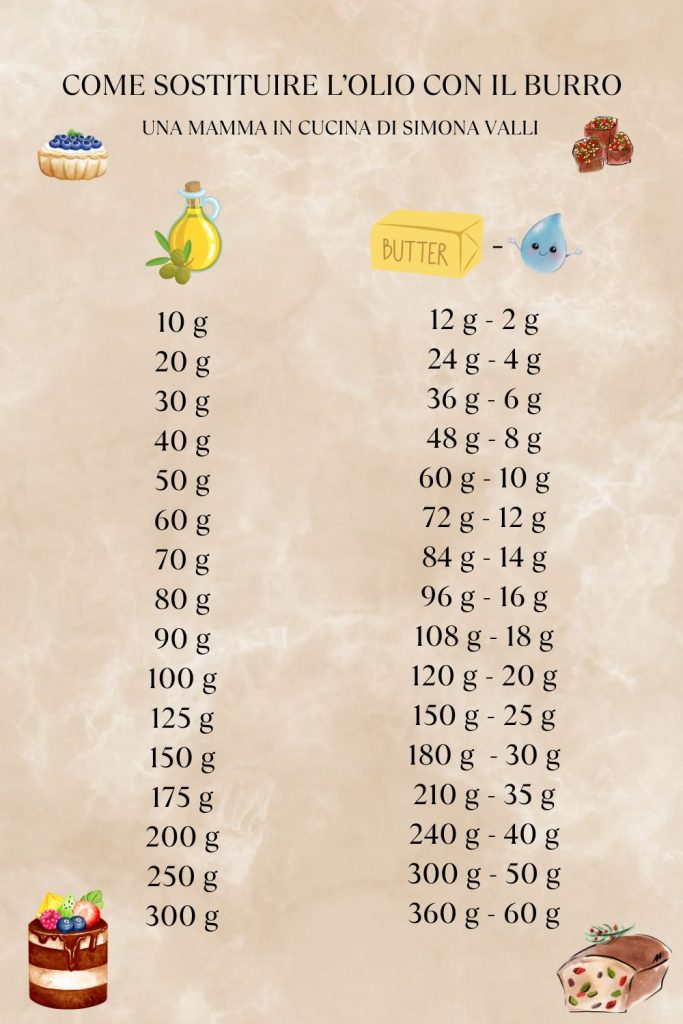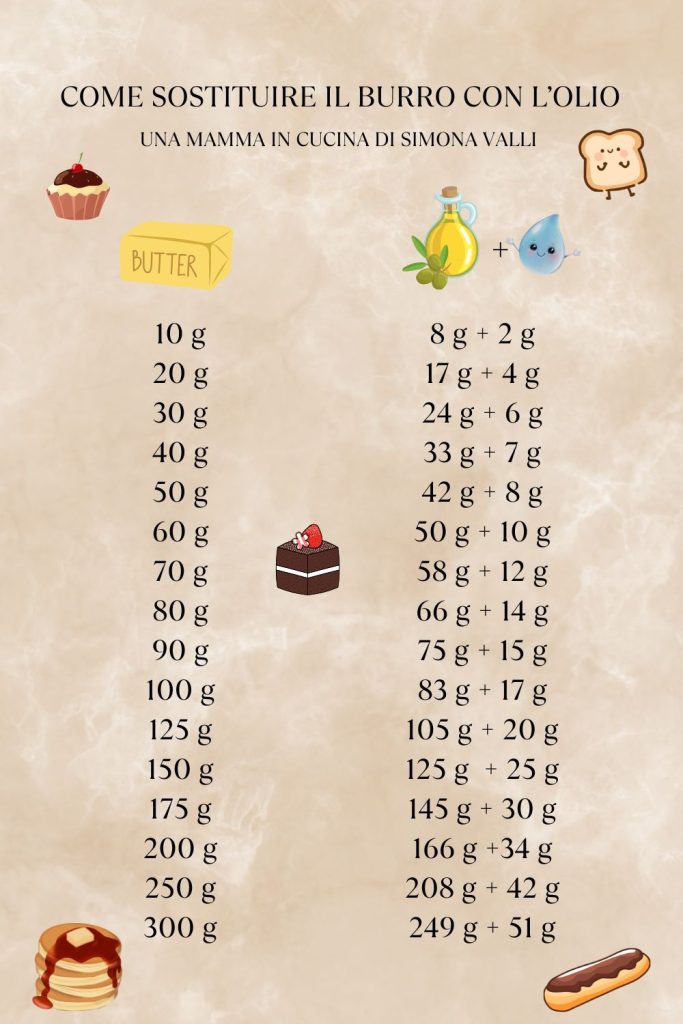Every day I publish new recipes, I love baking, I have been attending courses for years and I can’t wait to put into practice what I study.
When I prepare simple desserts like my 5-minute cakes or breakfast cakes you often ask me how to replace oil with butter and vice versa.
The choice stems from health issues, personal tastes, or food intolerances.
If we compare the calories of oil to those of butter, we notice they are lower (758 Kcal per 100 g versus 900 for oil), but we must consider that butter contains about 17% water and it is precisely from this fact that I started to develop my tables.
Can you replace butter with oil? And can you do the opposite? Certainly!
Many tables circulate online, all identical but none consider that replacing these two fats leads to a liquid imbalance that needs to be calculated and modified. I have prepared two tables that you can use to achieve perfect desserts.
These substitutions can only be applied to simple cakes with egg mixture, muffins, cakes without mixture (like my 5-minute cakes), pancakes, or doughs like Carnival chiacchiere. These substitutions cannot be used for shortcrust pastry, puff pastry, or butter mixtures like the Paradise cake.
**********************************
Replacing oil with butter is very simple:
oil contains 100% fat
butter contains 83% fat and 17% water
If I have a dessert that contains 100 g of oil and I want to replace it with butter, I will need to add about 20% more, so I will use 120 g. Doing so automatically adds 20 g of water which will increase the liquids already present in the recipe.
To obtain a well-balanced mixture, we must, therefore, remove 20 g of liquids (milk, fruit juice, water) from the ingredients in the recipe.
And if I want to replace butter with oil?
If I have a dessert that contains 100 g of butter and I want to replace it with oil, I will need to decrease it by about 20%, so I will use 83 g. Doing so automatically removes 17 g of water which will decrease the liquids already present in the recipe.
To obtain a well-balanced mixture, we must, therefore, add 17 g of liquids (milk, fruit juice, water) to the ingredients in the recipe.
In the tables I have prepared, you will also find the amount of liquids you need to remove or add to your doughs in order to achieve cakes, muffins, and plumcakes that are perfectly soft and moist.
Here are some simple recipes to try

- Difficulty: Easy
- Cost: Inexpensive
- Cooking methods: Electric oven
- Cuisine: Italian
- Seasonality: All seasons
Ingredients
To simplify the fat substitution further, let me give you an example
- 2 cups all-purpose flour
- 3/4 cup sugar
- 1 packet baking powder
- 3 1/2 tbsp lemon juice
- 1/3 cup peanut oil
- 2 eggs (medium)
- 1/2 cup milk
- 1 tsp vanilla extract
- 1 tsp lemon zest (grated)
- 2 cups all-purpose flour
- 3/4 cup sugar
- 1 packet baking powder
- 3 1/2 tbsp lemon juice
- 6 tbsp butter (REPLACED OIL WITH BUTTER)
- 2 eggs (medium)
- 1/2 cup milk (REMOVED 14 g OF LIQUIDS)
- 1 tsp vanilla extract
- 1 tsp lemon zest
Oil – Butter and Butter – Oil Conversion Tables
Replacing oil with butter is very simple:
oil contains 100% fat
butter contains 83% fat and 17% water
If I have a dessert that contains 100 g of oil and I want to replace it with butter, I will need to add about 20% more, so I will use 120 g. Doing so automatically adds 20 g of water which will increase the liquids already present in the recipe.
To obtain a well-balanced mixture, we must, therefore, remove 20 g of liquids (milk, fruit juice, water) from the ingredients in the recipe.Here you find all the weights with the relative substitution and the quantity of liquids (water, milk, fruit juice, or other liquids) to be removed.
In the table, I have made some rounding to make it simpler.

If I have a dessert that contains 100 g of butter and I want to replace it with oil, I will need to decrease it by about 20%, so I will use 83 g. Doing so automatically removes 17 g of water which will decrease the liquids already present in the recipe.
To obtain a well-balanced mixture, we must, therefore, add 17 g of liquids (milk, fruit juice, water) to the ingredients in the recipe.Here you find all the weights with the relative substitution and the quantity of liquids (water, milk, fruit juice, or other liquids) to be added.
In the table, I have made some rounding to make it simpler.

Notes
For advice on recipe execution, contact me on FACEBOOK and, if you’d like, follow me on INSTAGRAM
Send me your photos, I will be happy to publish them on my social media
FAQ (Frequently Asked Questions)
Can this method be applied to all doughs?
No, it can be applied to simple doughs or egg mixtures; it is not possible to replace butter with oil in desserts like the Paradise cake, which is made with a butter mixture.
Can I use these tables to modify shortcrust pastry?
No, shortcrust pastry must be rebalanced each time a modification is made; this method can be used on traditional pastries that contain baking powder and little butter

